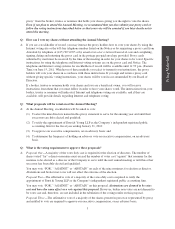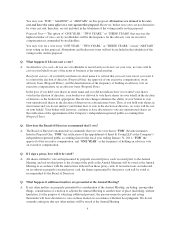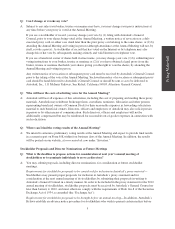Autodesk 2011 Annual Report Download - page 19
Download and view the complete annual report
Please find page 19 of the 2011 Autodesk annual report below. You can navigate through the pages in the report by either clicking on the pages listed below, or by using the keyword search tool below to find specific information within the annual report.
The say-on-pay vote is advisory, and therefore not binding on the Company, the Compensation Committee
or our Board of Directors. The say-on-pay vote will, however, provide information to us regarding investor
sentiment about our executive compensation philosophy, policies and practices, which the Compensation
Committee will consider when determining executive compensation for the remainder of the current fiscal year
and beyond. Our Board of Directors and our Compensation Committee value the opinions of our stockholders
and to the extent there is any significant vote against the named executive officer compensation as disclosed in
this proxy statement, we intend to communicate directly with stockholders to better understand the concerns that
influenced the vote, consider our stockholders’ concerns and evaluate whether any actions are necessary to
address those concerns.
Following is a summary of some of the key points of our 2011 executive compensation program. See the
“Executive Compensation” section beginning on page 16 below for more information.
Executive Compensation Decisions for Fiscal 2011
Our compensation program for fiscal 2011 was established at the beginning of fiscal 2011 during a period of
uncertainty. The global economy appeared to continue to be in recession, and many macroeconomic concerns
remained from the prior year. In addition, the Company had experienced one of its most difficult financial years
during fiscal 2010, and cost controls continued to be emphasized during that period. Against this backdrop, our
Compensation Committee took a prudent and conservative approach to setting our Named Executive Officers’
compensation by freezing most Named Executive Officers’ base salaries, reducing the amount of funding for the
Company’s executive short-term cash incentive plan, shifting compensation to further emphasize achievement of
our operating goals and continuing its practice of long term incentives through stock option grants.
While the basic elements of our compensation program for fiscal 2011—base salary, short-term incentives
and long-term incentives—were generally consistent with the elements of our programs in previous fiscal years,
the Compensation Committee sought to be conservative in its compensation approach while providing
meaningful incentives to achieving our financial goals.
Financial Performance in Fiscal 2011 and its Effect on Executive Compensation Paid for Fiscal 2011
Despite a continued difficult business and economic environment, we experienced an increase in demand for
our products and services in all of the geographies and industries we serve during fiscal 2011 as compared to
fiscal 2010. This positively impacted our financial results and stock price. In addition, we continued to make
progress in controlling our operating costs, which led to year over year improvements in our non-GAAP
operating margin. We believe that the improvements in these areas are indications of a broad-based stabilization
of our business. The table below sets forth the improvements in our revenue, non-GAAP income from operations
and non-GAAP operating margin from fiscal 2010 to fiscal 2011:
Fiscal 2011 Fiscal 2010 Change
(in millions, except percentages)
Revenue ...................................... $1,951.8 $1,713.7 14%
Non-GAAP income from operations ................ $ 418.8 $ 286.8 46%
Non-GAAP operating margin ..................... 21% 17% 28%
Our total stockholder return during fiscal 2011 was 71%, with the Company’s stock price appreciating from
$23.81 on the first day of fiscal 2011 to $40.68 on the last day of fiscal 2011, with the stock price reaching its
highest price of $42.03 and its lowest price of $22.95 during that period.
Compensation Governance Practices
A number of fundamental elements of our compensation programs support our overall philosophy, which in
practice are reflected in a number of our programs and practices, such as: paying-for-performance; a mix of
13
























